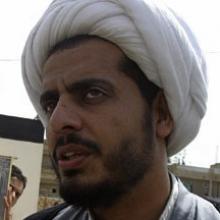
Qais al-Khazali
Leader
AAH is an Iranian-backed Shiite militia and political party operating primarily in Iraq, as well as in Syria and Lebanon. Until the U.S. military withdrawal from Iraq in December 2011, AAH had launched more than 6,000 attacks on American and Iraqi forces.
December 27, 2023: The IRI releases a statement claiming responsibility for attacking an undisclosed target in the Israel-held Golan Heights. The Israel Defense Forces (IDF) reportedly locate an explosive-laden drone that was launched from Syrian territory. Media reports speculate that IRI’s failed attack could be in response to Israel’s targeted killing of Islamic Revolutionary Guards Corp (IRGC) officer Reza Mousavi in Damascus, Syria, on December 25.Joe Truzman and Bill Roggio, “Network of Iraqi militias claim responsibility for attack in Israel,” Long War Journal, December 28, 2023, https://www.longwarjournal.org/archives/2023/12/network-of-iraqi-militias-claim-responsibility-for-attack-in-israel.php.
Asaib Ahl al-Haq (AAH) is an Iranian-backed Shiite militia and political party operating primarily in Iraq, as well as in Syria and Lebanon.Yaroslav Trofimov, “After Mosul, Will Iraq’s Shiite Militias Head to Syria?” Wall Street Journal, December 29, 2016, https://www.wsj.com/articles/after-mosul-will-iraqs-shiite-militias-head-to-syria-next-1483007404;
Matthew Hilburn, “One-time US Prisoner Now Key in Battling IS,” Voice of America, last modified March 15, 2015, http://www.voanews.com/content/qais-khazali-onetime-us-prisoner-now-key-in-battling-islamic-state/2679431.html;
“Iraq: High Electoral Commission Grants License To Shiite Militia,” Stratfor, May 24, 2017, https://www.stratfor.com/situation-report/iraq-high-electoral-commission-grants-license-shiite-militia. The group is implicated in numerous acts of sectarian violence and potential war crimes in Iraq and Syria.“Iraq: Turning a Blind Eye: the Arming of the Popular Mobilization Units,” Amnesty International, January 2017, https://www.amnesty.org/en/documents/mde14/5386/2017/en/;
“Iraq: Ban Abusive Militias from Mosul Operation,” Human Rights Watch, July 31, 2016, https://www.hrw.org/news/2016/07/31/iraq-ban-abusive-militias-mosul-operation.
Formed in 2006 by Qais al-Khazali, AAH has between 7,000 and 10,000 members and is one of the most powerful Shiite militias in Iraq.Matthew Hilburn, “One-time US Prisoner Now Key in Battling IS,” Voice of America, last modified March 15, 2015, http://www.voanews.com/content/qais-khazali-onetime-us-prisoner-now-key-in-battling-islamic-state/2679431.html; Phillip Smyth, “Iranian Militias in Iraq's Parliament: Political Outcomes and U.S. Response,” Washington Institute for Near East Policy, June 11, 2018, http://www.washingtoninstitute.org/policy-analysis/view/iranian-militias-in-iraqs-parliament-political-outcomes-and-u.s.-response. Until the U.S. military withdrawal from Iraq in December 2011, AAH launched more than 6,000 attacks on American and Iraqi forces, including highly sophisticated operations and targeted kidnappings of Westerners.Liz Sly, “Iranian-backed militant group in Iraq is recasting itself as a political player,” Washington Post, February 18, 2013, http://www.washingtonpost.com/world/middle_east/iranian-backed-militant-group-in-iraq-is-recasting-itself-as-a-political-player/2013/02/18/b0154204-77bb-11e2-b102-948929030e64_story.html; Sam Wyer, “The Resurgence of Asa’ib Ahl al-Haq,” Middle East Security Report 7 (December 2012): 6, http://www.understandingwar.org/sites/default/files/ResurgenceofAAH.pdf. The group seeks to promote Iran’s political and religious influence in Iraq, maintain Shiite control over Iraq, and oust any remaining Western vestiges from the country.Michael Knights, “Iran's Ongoing Proxy War in Iraq,” Washington Institute for Near East Policy, March 16, 2009, http://www.washingtoninstitute.org/policy-analysis/view/irans-ongoing-proxy-war-in-iraq.
AAH broke away from the Mahdi Army (JAM), the militia run by influential Shiite cleric Muqtada al-Sadr, in 2006.Marisa Cochrane, “Asaib Ahl al‐Haq and the Khazali Special Groups Network,” Institute for the Study of War, January 13, 2008, 9, http://www.understandingwar.org/sites/default/files/reports/Asaib Ahl al Haq and the Khazali Special Groups Network.pdf. In August 2007, the U.S. designated AAH a “Special Group,” a label given to Iranian-backed Shiite militias operating in Iraq.Marisa Cochrane, “Asaib Ahl al‐Haq and the Khazali Special Groups Network,” Institute for the Study of War, January 13, 2008, 9, http://www.understandingwar.org/sites/default/files/reports/Asaib Ahl al Haq and the Khazali Special Groups Network.pdf. On January 3, 2020, U.S. Secretary of State Mike Pompeo announced that the U.S. government would designate AAH as a Foreign Terrorist Organization.“State Department Terrorist Designations of Asa’ib Ahl al-Haq and its leaders, Qays and Laith al-Khazali,” U.S. Department of State, January 3, 2020, https://www.state.gov/state-department-terrorist-designations-of-asaib-ahl-al-haq-and-its-leaders-qays-and-laith-al-khazali/. AAH is one of three prominent Iraqi Shiite militias funded and trained by Iran’s external military wing, the Quds Force of the Islamic Revolutionary Guards Corps (IRGC). AAH overtly displays its loyalty to Iran’s leaders, including the current supreme leader, Ayatollah Ali Khamenei, and his predecessor, the late Ayatollah Ruhollah Khomeini.Qassim Abdul-Zahra and Lara Jakes, “Iran ayatollah is poster boy for influence in Iraq,” Associated Press, September 25, 2012, http://bigstory.ap.org/article/iran-ayatollah-poster-boy-influence-iraq. In Iraq, and reportedly in Syria as well, the group operates under the command of Iran’s Quds Force.Babak Dehghanpisheh, “Special Report: The fighters of Iraq who answer to Iran,” Reuters, November 12, 2014, http://www.reuters.com/article/2014/11/12/us-mideast-crisis-militias-specialreport-idUSKCN0IW0ZA20141112. Following the January 3, 2020, assassination of Quds Force commander Qasem Soleimani in Iraq, AAH joined with other Iranian-sponsored Iraqi militias in vowing revenge on the United States.Simon Kerr, Chloe Cornish, and Andrew England, “Middle East braced for backlash after killing of Qassem Soleimani,” Financial Times, January 3, 2020, https://www.ft.com/content/52a2fce4-2e0f-11ea-a126-99756bd8f45e; Shelly Kittleson, “Iraqi armed factions vow revenge for Shiite commanders’ killings,” Al-Monitor, January 5, 2020, https://www.al-monitor.com/pulse/originals/2020/01/soleimani-assassination-iran-iraq-us-pmu.html.
Following the U.S. withdrawal from Iraq in December 2011, AAH announced its intention to lay down its weapons and enter Iraqi politics.Sam Wyer, “The Resurgence of Asa’ib Ahl al-Haq,” Middle East Security Report 7 (December 2012): 6, http://www.understandingwar.org/sites/default/files/ResurgenceofAAH.pdf. The group opened a number of political offices and religious schools and offered social services to widows and orphans.Liz Sly, “Iranian-backed militant group in Iraq is recasting itself as a political player,” Washington Post, February 18, 2013, http://www.washingtonpost.com/world/middle_east/iranian-backed-militant-group-in-iraq-is-recasting-itself-as-a-political-player/2013/02/18/b0154204-77bb-11e2-b102-948929030e64_story.html. According to a Reuters report, “The model [AAH] uses is Hezbollah in Lebanon,” another Iranian proxy.Babak Dehghanpisheh, “Special Report: The fighters of Iraq who answer to Iran,” Reuters, November 12, 2014, http://www.reuters.com/article/2014/11/12/us-mideast-crisis-militias-specialreport-idUSKCN0IW0ZA20141112.
The Shiite-led Iraqi government of Prime Minister Nouri al-Maliki reportedly welcomed AAH into politics,Jack Healy and Michael S. Schmidt, “Political Role for Militants Worsens Fault Lines in Iraq,” New York Times, January 5, 2012, http://www.nytimes.com/2012/01/06/world/middleeast/iraqi-moves-to-embrace-militia-opens-new-fault-lines.html?_r=1. noting that Khazali had “committed no crime under Iraqi law” and was therefore “welcome to play a role in public life.”Martin Chulov, “Qais al-Khazali: from kidnapper and prisoner to potential leader,” Guardian, December 31, 2009, http://www.theguardian.com/world/2009/dec/31/iran-hostages-qais-al-khazali. According to analyst Sam Wyer, AAH “expanded at an unprecedented and alarming rate.”Sam Wyer, “The Resurgence of Asa’ib Ahl al-Haq,” Middle East Security Report 7 (December 2012): 6, http://www.understandingwar.org/sites/default/files/ResurgenceofAAH.pdf. The group formed a political bloc, al-Sadiqun (the Honest Ones), and ran under al-Maliki’s State of Law bloc in the April 2014 Iraqi national elections, winning one seat.Nicholas A. Heras, “Iraqi Shi'a Militia Asa’ib Ahl al-Haq Expands Operations to Syria,” Jamestown Foundation, May 15, 2014, http://www.jamestown.org/single/?tx_ttnews%5Btt_news%5D=42367&no_cache=1#.VTlNmiHBzGc; John Hall, “Shocking image shows child aged under ten being used to fire rockets from car-mounted missile launcher in Iraq against ISIS targets,” Daily Mail (London), December 24, 2014, http://www.dailymail.co.uk/news/article-2885162/Chilling-image-shows-child-aged-ten-used-fire-rockets-car-mounted-missile-launcher-Iraq-against-ISIS-targets.html. AAH’s political branch has since sought to distance itself from the group’s militant branch, accused by international human rights organizations of various war crimes. In an effort to soften its image, AAH has removed the rifle from its official logo and has begun referring to itself as the “Asaib movement.”Omar Sattar, “Why Iraq’s law on Popular Mobilization Units isn't all that popular,” Al-Monitor, March 8, 2017, http://www.al-monitor.com/pulse/originals/2017/03/iraq-election-pmu-shiite-militias-abadi.html#ixzz4bQMI6UB4. In May 2017, the group earned a license to operate as a political party and run in the next Iraqi elections under its own name.“Iraq: High Electoral Commission Grants License To Shiite Militia,” Stratfor, May 24, 2017, https://www.stratfor.com/situation-report/iraq-high-electoral-commission-grants-license-shiite-militia.
Since entering politics, AAH has not fulfilled its vow to halt armed resistance, instead continuing to carry out sectarian violence,Hannah Allam, “Shiite militias: the other ‘foreign fighters’ in Iraq,” McClatchy DC, November 20, 2013, http://www.mcclatchydc.com/2013/11/20/209160/shiite-militias-the-other-foreign.html. execute homophobic attacks,Samuel Oakford and Sally Hayden, “Caught Between the Islamic State and Shiite Militias, Gays Are Dying in Iraq,” VICE News, November 19, 2014, https://news.vice.com/article/caught-between-the-islamic-state-and-shiite-militias-gays-are-dying-in-iraq. and threaten the “interests” of Western countries participating in strikes in Syria.Qassim Abdul-Zahra and Adam Schreck, “Iraqi officials, militants warn of threat to US,” Associated Press, September 6, 2013, http://bigstory.ap.org/article/iraqi-officials-militants-warn-threat-us. One of AAH’s Syrian offshoots—the IRGC-backed Harakat al Nujaba militia—is reportedly the largest Iraqi militia operating in Aleppo, where reports of war crimes against Sunni civilians are widespread. Another AAH offshoot, Imam Ali Brigades, dispatched forces to both Aleppo and Palmyra in 2016.Amir Toumaj, “Array of pro-Syrian government forces advances in Aleppo,” Long War Journal, December 9, 2016, http://www.longwarjournal.org/archives/2016/12/array-of-pro-syrian-government-forces-advance-in-aleppo.php. AAH forces are themselves reported to maintain unofficial units in Syria under the direct control of Qasem Soleimani.Martin Chulov, Saeed Kamali Dehghan, and Patrick Wintour, “Iran hails victory in Aleppo as Shia militias boost Syria's Bashar al-Assad,” Guardian (London), December 14, 2016, https://www.theguardian.com/world/2016/dec/14/iran-aleppo-syria-shia-militia. Meanwhile, the group is itself suspected of carrying out war crimes, alleged to be behind a series of abductions, killings, and torture targeting hundreds of Sunni boys and men in Iraq’s eastern Diyala province.“Iraq: Turning a Blind Eye: the Arming of the Popular Mobilization Units,” Amnesty International, January 2017, https://www.amnesty.org/en/documents/mde14/5386/2017/en/. AAH has also recruited former ISIS members in the province, who are used to stoke anti-Kurdish violence in the areas under its control.Michael Knights and Frzand Sherko, “Can Asaib Ahl al-Haq Join the Political Mainstream?,” Washington Institute, February 14, 2019, https://www.washingtoninstitute.org/policy-analysis/view/can-asaib-ahl-al-haq-join-the-political-mainstream.
AAH is one of the leading militias in Iraq’s anti-ISIS volunteer forces, Haashid Shaabi (also known as the Popular Mobilization Forces/Units or PMF/PMU).Saif Hameed, “UPDATE 4-Iraq special forces advance in Tikrit, U.S. coalition joins fight,” Reuters, March 26, 2015, http://www.reuters.com/article/2015/03/26/mideast-crisis-iraq-idUSL6N0WS1MM20150326. Despite reports of sectarian atrocities and war crimes, AAH and other PMF militias—including the Badr Organization and the U.S.-designated Kata’ib Hezbollah—were formally recognized by Iraqi Parliament in November 2016.Hamza Hendawi and Qassim Abdul-Zahra, “Iraq’s parliament adopts law legalizing Shiite militias,” Associated Press, November 26, 2016, http://bigstory.ap.org/article/38d21400b14444b08d8169ca03ecdb1b/mortars-kill-16-iraqi-civilians-mosul. In January 2018, AAH, Kata’ib Hezbollah (KH), and the Badr Organization joined with other PMF units to form the Fatah Alliance political party in preparation for Iraq’s May 2018 elections.Ahmad Majidyar, “Iraqi Hezbollah calls on Baghdad government to set up US exit timeline,” Middle East Institute, March 6, 2018, http://www.mei.edu/content/io/iraqi-hezbollah-calls-baghdad-government-set-us-exit-timeline. The alliance won 47 parliamentary seats in the election, though the parliament soon after initiated a manual recount.“Iraqi parliament orders manual election recount,” BBC News, June 6, 2018, https://www.bbc.com/news/world-middle-east-44390092; Sinan Salaheddine, “Iraq expands manual recount to 7 provinces,” Washington Post, July 9, 2018, https://www.washingtonpost.com/world/middle_east/iraq-starts-manual-recount-for-more-ballots-from-may-vote/2018/07/09/24c20976-8354-11e8-9e06-4db52ac42e05_story.html?noredirect=on&utm_term=.0b3f886b5e39. In June, Fatah formed a coalition agreement with Muqtada al-Sadr’s Sairoon Alliance, which won the Iraq elections.Phillip Smyth, “Iranian Militias in Iraq's Parliament: Political Outcomes and U.S. Response,” Washington Institute for Near East Policy, June 11, 2018, http://www.washingtoninstitute.org/policy-analysis/view/iranian-militias-in-iraqs-parliament-political-outcomes-and-u.s.-response; Ali Mamouri, “Sadr allies with Iran-backed coalition to form government in Iraq,” Al-Monitor, June 14, 2018, https://www.al-monitor.com/pulse/originals/2018/06/iraq-election-muqtada-sadr-sairoon-fatah-hadi-amiri-iran.html. Following a country-wide recount, AAH was awarded 15 seats in the parliament.Michael Knights and Frzand Sherko, “Can Asaib Ahl al-Haq Join the Political Mainstream?,” Washington Institute, February 14, 2019, https://www.washingtoninstitute.org/policy-analysis/view/can-asaib-ahl-al-haq-join-the-political-mainstream. This new coalition places Fatah—and by extension AAH—in a position to influence the new Iraq government. Under the newly formed government, AAH member Abdul-Amir Hamdani was given the position of minister of culture.Michael Knights and Frzand Sherko, “Can Asaib Ahl al-Haq Join the Political Mainstream?,” Washington Institute, February 14, 2019, https://www.washingtoninstitute.org/policy-analysis/view/can-asaib-ahl-al-haq-join-the-political-mainstream. On July 13, 2018, Iraqi protesters in the country’s south attacked the political offices of AAH and other Iran-backed groups as they called for Iran to withdraw from Iraq.Seth J. Frantzman, “Mass Protests Sweep Iraq, Target Pro-Iran Militias and Parties,” Jerusalem Post, July 16, 2018, https://www.jpost.com/Middle-East/Mass-protests-sweep-Iraq-target-pro-Iran-militias-and-parties-562597.
On July 1, 2019, Iraqi Prime Minister Adil Abdul Mahdi issued a decree ordering the militias of the PMF to choose between full integration into the Iraqi armed forces or disarmament by July 31. The prime minister’s decree stated that the PMF factions had to choose between either political or paramilitary activity, and if they choose politics they would not be allowed to carry weapons.Jared Szuba, “Mahdi orders full integration of Shia militias into Iraq’s armed forces,” July 3, 2019, https://thedefensepost.com/2019/07/03/iraq-mahdi-orders-popular-mobilization-units-integration/.; “Shia militia agrees to integrate into Iraq state army,” Middle East Monitor, July 3, 2019, https://www.middleeastmonitor.com/20190703-shia-militia-agrees-to-integrate-into-iraq-state-army/. The decree was an attempt by Abdul Mahdi at curtailing the autonomy of Iranian-backed militias, which boast more than 120,000 fighters. Some critics suggested the United States and Saudi Arabia instigated the decree after U.S. officials concluded that drone attacks on Saudi Arabia’s oil pipeline in May 2018 were launched from Iraq, not Yemen, which raised the concerns over the activities of Iran-backed militias in Iraq.Isabel Coles in Beirut and Dion Nissenbaum, “U.S.: Saudi Pipeline Attacks Originated From Iraq,” Washington Post, June 28, 2019, https://www.wsj.com/articles/u-s-saudi-pipeline-attacks-originated-from-iraq-11561741133.
U.S. officials want the Iraqi government to do more to rein in Iranian-allied militias that have grown in power since they helped win the war against ISIS, including preventing them from using Iraqi territory as a launchpad for attacks against the American military or its allies. According to Mahdi’s decree, all PMF factions must abandon their old names and receive new names in compliance with the regulations of the Iraqi army. The decree forbade political parties and parliamentary blocs from having ties with the PMF. Also, all the headquarters, economic offices, and checkpoints manned by militias are to be shut down.Ali Mamouri, “Iraq orders militias to fully integrate into state security forces,” Al Monitor, July 2, 2019, https://www.al-monitor.com/pulse/originals/2019/07/iraq-pmu-iran-abdul-mahdi-shiite-militias.html#ixzz5smS9aPBp. Unlike other leaders in the PMF, AAH’s leader Qais al-Khazali supported the decree.Rafid Jaboori, “Iraqi Prime Minister’s Decree will not Undermine Power of Iran-backed Militias,” The Jamestown Foundation, August 9, 2019, https://jamestown.org/program/iraqi-prime-ministers-decree-will-not-undermine-power-of-iran-backed-militias/.; “Iraqi militias want more time to integrate into army,” Middle East Eye, July 31, 2019, https://www.middleeasteye.net/news/iraqi-militia-recruitment-centres-closed-integration-deadline-passes. Abdul Mahdi issued a new decree in September 2019 that restructured the PMF’s leadership.Fadhel al-Nashmi, “Iraqi PM Issues New order on PMF Restructuring,” Asharq al-Awsat (London), September 22, 2020, https://aawsat.com/english/home/article/1913381/iraqi-pm-issues-new-order-pmf-restructuring.
AAH is a religiously motivated group with allegiance to Iran. The group is demonstrably anti-American and sectarian in its ideology.
AAH seeks to establish an Islamist, Shiite-controlled Iraq and promote Iranian objectives.David D. Kirkpatrick, “Shiite Militants Pose Challenge for U.S. in Iraq,” New York Times, September 16, 2014, http://www.nytimes.com/2014/09/17/world/middleeast/shiite-militias-pose-challenge-for-us-in-iraq.html; Sam Wyer, “The Resurgence of Asa’ib Ahl al-Haq,” Middle East Security Report 7 (December 2012): 6, http://www.understandingwar.org/sites/default/files/ResurgenceofAAH.pdf; Martin Chulov, “Controlled by Iran, the deadly militia recruiting Iraq’s men to die in Syria,” Guardian (London), March 12, 2014, http://www.theguardian.com/world/2014/mar/12/iraq-battle-dead-valley-peace-syria. While AAH has origins within the Iraqi Sadrist movement, the group is openly loyal to Iranian leaders, most notably the Ayatollahs Khomeini and Khamenei. Similarly, AAH shows deference to the Guardianship of the Jurists (velayat-e faqih), a judicial system that serves as one of the cornerstones of Iran’s Islamic Revolution system.Sam Wyer, “The Resurgence of Asa’ib Ahl al-Haq,” Middle East Security Report 7 (December 2012): 9, http://www.understandingwar.org/sites/default/files/ResurgenceofAAH.pdf. Writing for the Institute for the Study of War, analyst Sam Wyer characterizes AAH as a Khomeinist organization that aims “to create a suitable environment for the return of Imam Mahdi through the imposition of strict Shi’a Islamic governance.”Sam Wyer, “The Resurgence of Asa’ib Ahl al-Haq,” Middle East Security Report 7 (December 2012), http://www.understandingwar.org/sites/default/files/ResurgenceofAAH.pdf. Wyer’s assessment is corroborated by Guardian Middle East correspondent Martin Chulov, who writes that AAH is a “proxy arm of the Revolutionary Guards’ al-Quds Brigades, whose main brief is to export Iran’s 30-year-old Islamic Revolution.”Martin Chulov, “Qais al-Khazali: from kidnapper and prisoner to potential leader,” Guardian, December 31, 2009, http://www.theguardian.com/world/2009/dec/31/iran-hostages-qais-al-khazali. AAH is also ideologically aligned with Iranian proxy Hezbollah, a Shiite Lebanese terrorist group.Liz Sly, “Iranian-backed militant group in Iraq is recasting itself as a political player,” Washington Post, February 18, 2013, http://www.washingtonpost.com/world/middle_east/iranian-backed-militant-group-in-iraq-is-recasting-itself-as-a-political-player/2013/02/18/b0154204-77bb-11e2-b102-948929030e64_story.html.
AAH is also virulently anti-American, a stance that has not abated since the U.S. withdrawal from Iraq in December 2011. In March 2015, for example, AAH boycotted the Haashid Shaabi (Popular Mobilization Forces) attack against ISIS in Tikrit because AAH rejected U.S. airpower support.Saif Hameed, “UPDATE 4-Iraq special forces advance in Tikrit, U.S. coalition joins fight,” Reuters, March 26, 2015, http://www.reuters.com/article/2015/03/26/mideast-crisis-iraq-idUSL6N0WS1MM20150326. By the end of the month, AAH only agreed to rejoin the battle after Iraqi Prime Minister Haider al-Abadi promised that the U.S. would stop its airstrikes.Loveday Morris, “Shiite militias in Iraq say they have assurances that U.S. will stop strikes,” Washington Post, March 30, 2015, http://www.washingtonpost.com/world/middle_east/shiite-militias-in-iraq-say-they-have-assurances-that-us-will-stop-strikes/2015/03/30/cf14a4bc-d6da-11e4-bf0b-f648b95a6488_story.html. AAH Spokesman Naim al-Aboudi said that the prime minister “realized this battle can’t be finished” without AAH and other militias,Loveday Morris, “Shiite militias in Iraq say they have assurances that U.S. will stop strikes,” Washington Post, March 30, 2015, http://www.washingtonpost.com/world/middle_east/shiite-militias-in-iraq-say-they-have-assurances-that-us-will-stop-strikes/2015/03/30/cf14a4bc-d6da-11e4-bf0b-f648b95a6488_story.html. demonstrating AAH’s continued prioritizing of its anti-American position above its other goals.
As a Shiite, Iranian-backed group, AAH also follows and implements a sectarian ideology that has deepened the fault lines between Sunnis and Shiites. According to Martin Chulov, AAH leader Qais al-Khazali’s speeches have galvanized “thousands” of Iraqi Shiites to fight for Assad’s regime in Syria, worrying many Iraqi communities about “a sectarian conflict that increasingly respects no border.”Martin Chulov, “Controlled by Iran, the deadly militia recruiting Iraq’s men to die in Syria,” Guardian (London), March 12, 2014, http://www.theguardian.com/world/2014/mar/12/iraq-battle-dead-valley-peace-syria. In August 2012, AAH militants reportedly bombed the Sunni Sabatayn Mosque in Iraq, an attack that stirred a new wave of sectarian tensions in the country.Sam Wyer, “The Resurgence of Asa’ib Ahl al-Haq,” Middle East Security Report 7 (December 2012): 17, http://www.understandingwar.org/sites/default/files/ResurgenceofAAH.pdf; “Shia militia attack on Sunni mosque in Iraq leaves scores dead,” Guardian (London), August 22, 2014, http://www.theguardian.com/world/2014/aug/22/shia-attack-sunni-mosque-iraq. Since then, Human Rights Watch has documented numerous AAH attacks on Sunnis in Iraq in which AAH militants target Sunni mosques or towns.“Iraq: Pro-Government Militias’ Trail of Death,” Human Rights Watch, July 31, 2014, http://www.hrw.org/news/2014/07/31/iraq-pro-government-militias-trail-death; “Iraq: Militias Escalate Abuses, Possibly War Crimes,” Human Rights Watch, February 15, 2015, http://foreignpolicy.com/2014/01/29/the-vocabulary-of-sectarianism/?wp_login_redirect=0. In December 2016, AAH leader Qais al-Khazali was interviewed on Iraqi TV saying that “[a]fter ISIS, Kurds are the greatest problem.”“Shiite militia spokesman denies ‘Kurds are biggest problem after ISIS,’” Rudaw, December 17, 2016, http://www.rudaw.net/english/middleeast/iraq/171220162. In response, a representative from the Kurdish Peshmerga ministry said that Khazali is responsible for “behead[ing] hundreds of Iraqis based on [their] ethnic or religious identity” and asserting that he “must be tried for these crimes.”“Peshmerga ministry says Shiite leader should be tried for sectarian crimes,” Rudaw, December 16, 2016, http://www.rudaw.net/english/kurdistan/161220161.
In line with this sectarian strife, AAH members have reportedly appropriated the derogatory term rafidah (a pejorative meaning “rejecters” that some Sunnis use for Shiites) as a badge of honor and “self-identity.” A January 2014 Foreign Policy piece reported that on an AAH linked-webpage, AAH proudly identified its fighters as rafidah “as a sign of mocking defiance against their foes.”Aaron Y. Zelin and Phillip Smyth, “The Vocabulary of Sectarianism,” Foreign Policy, January 29, 2014, http://foreignpolicy.com/2014/01/29/the-vocabulary-of-sectarianism/?wp_login_redirect=0.
Ahead of the May 2018 Iraqi elections, AAH updated their website with a new political platform that reflected a more moderate position. The core of AAH’s platform is achieving “the supreme interests of the Iraqi state in preserving its sovereignty and guaranteeing its freedom in its decision-making, achieving social and economic welfare, and stabilizing the security of our people according to the available capabilities.” Yet while AAH voices support for the Iraqi constitution, the group argues that it “was written in particular circumstances and contains several paragraphs that must be reviewed and adapted to align with the nature and need of the Iraqi people.” AAH’s platform also denounces the use of violence to “impose convictions” on the population and calls for respecting “religious, sectarian, and national diversity.” Lastly, while they make no explicit reference to Iraq’s relationship with the United States or Iran, they claim that “there is a real need to review the working machinery for the Iraqi embassies and representatives in all of the countries of the world and appointing ambassadors and diplomatic personnel.”“The political agenda of the Asa’ib Ahl al-Haq,” Asa’ib Ahl al-Haq Official Website, accessed June 30, 2018, http://ahlualhaq.com/index.php/permalink/5229.html.
AAH has so far taken no actions to support these new positions.
AAH is led by its founder, Qais al-Khazali, who broke off from the Mahdi Army (a.k.a. Jaysh al-Mahdi or JAM), a Sadrist militia, in 2006. According to a 2012 report by analyst Sam Wyer, Khazali sits on AAH’s five-person board of trustees along with two deputies. As an Iranian proxy, AAH coordinates with senior Iranian commanders, notably IRGC-Quds Force leader Qasem Soleimani.Sam Wyer, “The Resurgence of Asa’ib Ahl al-Haq,” Middle East Security Report 7 (December 2012): 9, http://www.understandingwar.org/sites/default/files/ResurgenceofAAH.pdf.
AAH first began as a military unit within JAM. With the 2003 Iraq War, AAH reorganized into battalions assigned to four sectors: Baghdad, Maysan, Najaf, and Samarra. When Khazali made AAH an independent group in 2006, he retained this structure. AAH’s military arrangement is thought to be based on fellow Shiite militant group Hezbollah, with which the group has close ties.Sam Wyer, “The Resurgence of Asa’ib Ahl al-Haq,” Middle East Security Report 7 (December 2012): 9, http://www.understandingwar.org/sites/default/files/ResurgenceofAAH.pdf. Within the PMF structure AAH operates three brigades, the 41st, 42nd, and 43rd.Aymenn Jawad Al-Tamimi, “Hashd Brigade Numbers Index,” Aymenn Jawad Al-Tamimi's Blog, October 31, 2017, http://www.aymennjawad.org/2017/10/hashd-brigade-numbers-index. AAH dominates the northern Baghdad belts and the southern Salah al-Din region of Iraq, including Taji, Dujail, and Balad. AAH also has economic and political power in the area from Samarra to Baghdad.Michael Knights, “Iran’s Expanding Militia Army in Iraq: The New Special Groups,” CTC Sentinel, Vol 12, Issue 17, August 2019, https://ctc.usma.edu/app/uploads/2019/08/CTC-SENTINEL-072019.pdf.
Since the U.S. withdrew its forces from Iraq in December 2011, AAH has expanded significantly into politics, “opening a string of political offices” throughout Iraq, according to the Washington Post.Liz Sly, “Iranian-backed militant group in Iraq is recasting itself as a political player,” Washington Post, February 18, 2013, http://www.washingtonpost.com/world/middle_east/iranian-backed-militant-group-in-iraq-is-recasting-itself-as-a-political-player/2013/02/18/b0154204-77bb-11e2-b102-948929030e64_story.html. AAH runs two political offices in Baghdad, and others in the Iraqi cities of Basra, Najaf, Hillah, al-Kalis, and Tal Afar. AAH has also sent political representatives to the southern Iraqi provinces of Dhi Qar, al-Muthanna, and Maysan to meet with tribal and minority leaders. In the April 2014 parliamentary elections, AAH ran in alliance with Prime Minister Maliki’s Dawlat al-Qanoon (State of Law) in a political bloc known as al-Sadiqun (the Honest Ones).Nicholas A. Heras, “Iraqi Shi'a Militia Asa'ib Ahl al-Haq Expands Operations to Syria,” Terrorism Monitor 12 (March 15, 2014): 10, http://www.jamestown.org/single/?tx_ttnews%5Btt_news%5D=42367&no_cache=1#.VTkRFCFViko. In addition to political operations within Iraq, AAH has also conducted political outreach outside of Iraq’s borders, AAH has maintained maintaining political representation in Beirut since early 2011.Sam Wyer, “The Resurgence of Asa’ib Ahl al-Haq,” Middle East Security Report 7 (December 2012): 9, http://www.understandingwar.org/sites/default/files/ResurgenceofAAH.pdf. Despite reports of sectarian atrocities and war crimes, AAH and other PMF militias (including the Badr Organization and the U.S.-designated Kata’ib Hezbollah) were formally recognized by Iraqi Parliament in November 2016.Hamza Hendawi and Qassim Abdul-Zahra, “Iraq’s parliament adopts law legalizing Shiite militias,” Associated Press, November 26, 2016, http://bigstory.ap.org/article/38d21400b14444b08d8169ca03ecdb1b/mortars-kill-16-iraqi-civilians-mosul. In May 2017, AAH received a license from the Iraqi government to operate a political party under its own name.“Iraq: High Electoral Commission Grants License To Shiite Militia,” Stratfor, May 24, 2017, https://www.stratfor.com/situation-report/iraq-high-electoral-commission-grants-license-shiite-militia.
In addition to operating in Iraq, AAH militants have also reportedly operated in Syria under the command of IRGC Quds Force commander Qasem Soleimani.Martin Chulov, Saeed Kamali Dehghan, and Patrick Wintour, “Iran hails victory in Aleppo as Shia militias boost Syria's Bashar al-Assad,” Guardian (London), December 14, 2016, https://www.theguardian.com/world/2016/dec/14/iran-aleppo-syria-shia-militia. The group’s Syrian offshoot—IRGC-backed Harakat al Nujaba militia—is the largest Iraqi militia operating in Aleppo, dispatching an estimated 3,000-4,000 fighters to Aleppo.Associated Press, “Syrian government press in their offensive on Alepp,” Fox News, October 4, 2016, http://www.foxnews.com/world/2016/10/04/syrian-government-press-in-their-offensive-on-aleppo.html;
Amir Toumaj, “Array of pro-Syrian government forces advances in Aleppo,” Long War Journal, December 9, 2016, http://www.longwarjournal.org/archives/2016/12/array-of-pro-syrian-government-forces-advance-in-aleppo.php. Another AAH offshoot, Imam Ali Brigades, dispatched forces to both Aleppo and Palmyra in 2016.Amir Toumaj, “Array of pro-Syrian government forces advances in Aleppo,” Long War Journal, December 9, 2016, http://www.longwarjournal.org/archives/2016/12/array-of-pro-syrian-government-forces-advance-in-aleppo.php.
AAH has continued to expand its influence in Iraq during the fight against ISIS. In March 2017, AAH leader Qais al-Khazali gave a speech calling for an Iraqi university run by the PMF paramilitary forces. As Khazali said, Iraq needs a “strong and effective ‘PMU University, through which we could address our enemies and tell them, ‘If you fear us now, you must know that the PMU is present in every university, college and department.’” Analysts have noted with concern that the call appears to mimic Iranian-style “cultural revolution” tactics from the 1970s. Following Khazali’s remarks, he released a statement saying that Iraqi students “need to organize their ranks, which would allow them to overthrow any corrupt government or regime.”Hassan al-Shanoun, “Shiite militias prepare for education 'revolution' in Iraq,” Al-Monitor, April 17, 2017, http://www.al-monitor.com/pulse/originals/2017/04/university-iraq-cultural-revolution-pmu.html.
In January 2018, AAH, Kata’ib Hezbollah (KH), and the Badr Organization joined with other PMF units to form the Fatah Alliance political party in preparation for Iraq’s May 2018 elections.Ahmad Majidyar, “Iraqi Hezbollah calls on Baghdad government to set up US exit timeline,” Middle East Institute, March 6, 2018, http://www.mei.edu/content/io/iraqi-hezbollah-calls-baghdad-government-set-us-exit-timeline. As a member of the Fatah Alliance, AAH exerts political influence in Iraq’s government. Prior to the elections, Khazali claimed that “the next prime minister will be someone chosen by the Fatah Alliance or selected in accordance with conditions set by the Fateh Alliance.”Ahmad Majidiyar, “Iran-backed Fateh Alliance seeks to win or play kingmaker in upcoming Iraqi elections,” Middle East Institute, May 3, 2018, http://www.mei.edu/content/io/iran-backed-fateh-alliance-seeks-win-or-play-kingmaker-upcoming-iraqi-elections. In May, the alliance exceeded expectations, winning 47 parliamentary seats in the election. The following month, Iraq’s parliament ordered a manual recount of the 11 million votes amid claims of fraud.“Iraqi parliament orders manual election recount,” BBC News, June 6, 2018, https://www.bbc.com/news/world-middle-east-44390092. Notwithstanding, on June 11, the Fatah Alliance formed a coalition government with Muqtada al-Sadr’s Sairoon Alliance, which received the largest number of parliamentary seats in the elections. The coalition placed Fatah in a position to obtain high-level government positions and have a final say in who will be Iraq’s next prime minister.Phillip Smyth, “Iranian Militias in Iraq's Parliament: Political Outcomes and U.S. Response,” Washington Institute for Near East Policy, June 11, 2018, http://www.washingtoninstitute.org/policy-analysis/view/iranian-militias-in-iraqs-parliament-political-outcomes-and-u.s.-response; Ali Mamouri, “Sadr allies with Iran-backed coalition to form government in Iraq,” Al-Monitor, June 14, 2018, https://www.al-monitor.com/pulse/originals/2018/06/iraq-election-muqtada-sadr-sairoon-fatah-hadi-amiri-iran.html. AAH, specifically, won 15 parliamentary seats in the May 2018 Iraqi elections, an increase from the one seat it won in 2014. One of AAH’s victorious candidates, Hassan Salam, was a former field commander in Sadr’s Mahdi Army who oversaw violent anti-Sunni gangs and later helped send Shiite jihadists to Syria.Phillip Smyth, “Iranian Militias in Iraq's Parliament: Political Outcomes and U.S. Response,” Washington Institute for Near East Policy, June 11, 2018, http://www.washingtoninstitute.org/policy-analysis/view/iranian-militias-in-iraqs-parliament-political-outcomes-and-u.s.-response; Sinan Salaheddine, “Iraq expands manual recount to 7 provinces,” Washington Post, July 9, 2018, https://www.washingtonpost.com/world/middle_east/iraq-starts-manual-recount-for-more-ballots-from-may-vote/2018/07/09/24c20976-8354-11e8-9e06-4db52ac42e05_story.html?noredirect=on&utm_term=.0b3f886b5e39. In June 2020, AAH succeeded in swaying new Iraqi Prime Minister Mustafa al-Kadhimi to sack his nominee for Iraq’s cultural minister in favor of a candidate selected by AAH, Hassan Nadhem.“Cabinet appointment illustrates militias’ hold on Iraq’s political system,” Arab Weekly, June 8, 2020, https://thearabweekly.com/cabinet-appointment-illustrates-militias-hold-iraqs-political-system.
Beginning in the spring of 2019, new Iran-backed militias appeared to emerge and claim responsibility for attacks against U.S. interests in Iraq. Foreign policy and media analysts in Iraq and the United States questioned the validity of claims from these groups based on suspicions they were recycling old video footage and claiming attacks without evidence.Hamdi Malik, “Pro-Iran militias in Iraq wage ‘fake news’ campaign against US,” Al-Monitor, June 2, 2020, https://www.al-monitor.com/pulse/originals/2020/06/iraq-militias-us-iran-pmu.html. AAH extensively utilizes front groups to claim attacks against Iraqi and U.S. military targets while concealing its own involvement in such operations. Ashab al-Kahf (“Companions of the Cave,” AK) is one of the oldest of these front groups, first appearing in 2019. It has been linked to both AAH and Kata’ib Hezbollah (KH). AK has claimed credit for IED attacks on convoys since March 2020. It has also claimed a November 17, 2020, rocket attack on Iraq’s U.S. Embassy and a February 15, 2021, rocket attack on Turkish forces.Crispin Smith, Hamdi Malik, Michael Knights, “Profile: Ashab al-Kahf,” Washington Institute for Near East Policy, April 1, 2021, https://www.washingtoninstitute.org/policy-analysis/profile-ashab-al-kahf; Evan Kohlmann, “Profile and Exclusive Interview with Iraqi Shiite Insurgents Ashab al-Kahf,” Flashpoint, August 20, 2020, https://flashpoint.io/blog/profile-and-exclusive-interview-with-iraqi-shiite-insurgents-ashab-al-kahf/. In August 2020, AK denied it has ties to AAH or any other militias.Evan Kohlmann, “Profile and Exclusive Interview with Iraqi Shiite Insurgents Ashab al-Kahf,” Flashpoint, August 20, 2020, https://flashpoint.io/blog/profile-and-exclusive-interview-with-iraqi-shiite-insurgents-ashab-al-kahf/. Nonetheless, that December the group declared it would unleash street violence if AAH ordered it.Crispin Smith, Hamdi Malik, Michael Knights, “Profile: Ashab al-Kahf,” Washington Institute for Near East Policy, April 1, 2021, https://www.washingtoninstitute.org/policy-analysis/profile-ashab-al-kahf In an August 1, 2022, statement, AK accused NATO, the United States, and the United Kingdom of enflaming political tensions in Iraq and threatened to attack their embassies and military bases in Iraq and around the Middle East.Zachary Coles and Nicholas Carl, “Iranian Proxies May Attack US in Response to Iraqi Political Crisis,” Critical Threats, August 3, 2022, https://www.criticalthreats.org/analysis/iranian-proxies-may-attack-us-in-response-to-iraqi-political-crisis. Another front group, Liwa Thar Muhandis (LTM) (“Revenge of Muhandis Brigade”), emerged in 2020 with claims of rocket attacks on U.S. forces on May 6 that year at Baghdad’s airport and an April 17 missile attack on U.S. helicopters. While the group has been suspected of links to both AAH and KH, some analysts suspect it has no capabilities for actual attacks and is used only to claim attacks.Crispin Smith, “Profile: Liwa Thar Muhandis,” Washington Institute for Near East Policy, July 8, 2021, https://www.washingtoninstitute.org/policy-analysis/profile-liwa-thar-muhandis.
Islamic Resistance in Iraq
Following the onset of the Hamas-Israel war in the Gaza Strip in early October 2023, an umbrella group called the Islamic Resistance in Iraq (IRI) claimed responsibility for an October 17 failed drone strike on an U.S. air base in Irbil, northern Iraq. The IRI is reportedly a coalition of all Iran-backed Shiite militias operating in Iraq. Among the groups included are AAH, Kataib Sayyid al-Shuhada (KSS), Kataib Hezbollah (KH), and Harakat Hezbollah al-Nujaba (HHN), as well as lesser-known militiassuch as Tashkil al-Waritheen. The IRI targets U.S. elements across Iraq and Syria in retaliation for the United States’ perceived role in the Gaza war. The IRI carried out at least 20 more attacks by the end of October. By January 2024, the IRI had carried out more than 100 attacks against U.S. targets in Iraq and Syria.Hamdi Malik and Michael Knights, “Profile: The Islamic Resistance in Iraq,” Washington Institute for Near East Policy, October 21, 2023, https://www.washingtoninstitute.org/policy-analysis/profile-islamic-resistance-iraq; “Iraq blames US-led coalition for ‘aggression’ after strike kills pro-Iran military commander,” France 24, January 4. 2024, https://www.france24.com/en/middle-east/20240104-iraq-blames-us-led-coalition-for-aggression-after-strike-kills-pro-iran-military-commander.
AAH has received training, arms, and financial support from Iran, particularly through Iran’s external military branch, the IRGC-Quds Force, as well as from Iran’s Lebanese proxy Hezbollah.Bill Roggio, “US breaks up Mahdi Army ‘Promised Day Brigade’ cell in Al Kut,” Long War Journal, April 26, 2009, http://www.longwarjournal.org/archives/2009/04/us_breaks_up_mahdi_a.php. Colonel Rick Welch, a retired U.S. Army intelligence officer, said that during the 2007 U.S. surge in Iraq, Iran was giving AAH “$20 million a month or some outrageous figure like that” in order to train AAH fighters.Michael Weiss, “Trust Iran Only as Far as You Can Throw It,” Foreign Policy, June 23, 2014, http://foreignpolicy.com/2014/06/23/trust-iran-only-as-far-as-you-can-throw-it/. After U.S. forces withdrew from Iraq in December 2011, the financial pipeline from Iran continued. As of 2012, Iran was giving AAH $5 million in cash and weapons per month, according to an Iraqi close to the group. As of March 2014, the group was receiving an estimated $1.5 million to $2 million a month from Iran.Associated Press, “Iraqi militia’s shift into politics could stoke tensions, strengthen Iran’s hand,” Daily Star (Beirut), January 9, 2012, http://www.dailystar.com.lb/News/Middle-East/2012/Jan-09/159183-iraqi-militias-shift-into-politics-could-stoke-tensions-strengthen-irans-hand.ashx; Martin Chulov, “Controlled by Iran, the deadly militia recruiting Iraq’s men to die in Syria,” Guardian (London), March 12, 2014, http://www.theguardian.com/world/2014/mar/12/iraq-battle-dead-valley-peace-syria.
AAH receives arms primarily from Iran and Russia, according to findings by Amnesty International. In January 2017, Amnesty International outlined various human rights abuses documented by AAH and other extremist Shiite militias in Iraq, and called upon foreign states to cease their “irresponsible arms transfers” to the extremist groups.“Iraq: End irresponsible arms transfers fuelling militia war crimes,” Amnesty International, January 5, 2017, https://www.amnesty.org/en/latest/news/2017/01/iraq-end-irresponsible-arms-transfers-fuelling-militia-war-crimes/. Amnesty International noted that AAH stands accused of egregious human rights violations and possible war crimes, including a wave of enforced disappearances, abductions, killings, and torture of Sunni boys and men.“Iraq: Turning a Blind Eye: the Arming of the Popular Mobilization Units,” Amnesty International, January 2017, https://www.amnesty.org/en/documents/mde14/5386/2017/en/. The group also stands accused of employing child soldiers, potentially as young as 11 years old.“Iraq: Turning a Blind Eye: the Arming of the Popular Mobilization Units,” Amnesty International, January 2017, https://www.amnesty.org/en/documents/mde14/5386/2017/en/.
AAH has recruited thousands of fighters, including child soldiers, according to findings by Human Rights Watch.Christopher Wilcke, “No Child's Play: Kids Fighting One Another in Iraq Conflict ,” Human Rights Watch, October 30, 2015, https://www.hrw.org/news/2015/10/30/no-childs-play-kids-fighting-one-another-iraq-conflict;
“Iraq: Turning a Blind Eye: the Arming of the Popular Mobilization Units,” Amnesty International, January 2017, https://www.amnesty.org/en/documents/mde14/5386/2017/en/. Fifteen-year-old Muthanna Qasim al-Kibali, for example, was killed in October 2015 while fighting alongside AAH.“Iraq: Turning a Blind Eye: the Arming of the Popular Mobilization Units,” Amnesty International, January 2017, https://www.amnesty.org/en/documents/mde14/5386/2017/en/.
AAH recruitment focuses on two strategies: traditional propaganda efforts to raise the group’s profile, and a comprehensive religious system aimed to indoctrinate and recruit members. AAH has also emulated groups like ISIS by using social media to expand recruitment throughout the Middle East, South Asia, and the West.Alessandria Masi, “Iraqi Shiite Militias Fighting ISIS Are Using Social Media To Recruit Foreign Fighters,” International Business Times, March 12, 2015, http://www.ibtimes.com/iraqi-shiite-militias-fighting-isis-are-using-social-media-recruit-foreign-fighters-1844118. The group also owns and operates Iraqi TV channel al-Aahd.“Iraq asks Saudi Arabia to replace envoy who riled Shi'ite militias,” Reuters, August 28, 2016, http://www.reuters.com/article/us-mideast-crisis-iraq-saudi-idUSKCN113095.
One of the main ways AAH draws recruits is by advertising itself as a protector of the Shiite community within Iraq and abroad. AAH uses posters and issues calls for recruits on Iraqi television stations, often emphasizing its connection with Iran and Hezbollah.Alessandria Masi, “Iraqi Shiite Militias Fighting ISIS Are Using Social Media To Recruit Foreign Fighters,” International Business Times, March 12, 2015, http://www.ibtimes.com/iraqi-shiite-militias-fighting-isis-are-using-social-media-recruit-foreign-fighters-1844118. One AAH member said that he was drawn to AAH because it was “protecting the Shiite community inside Iraq and abroad as well.”Tim Arango and Duraid Adnana, “Iraqi Militants Stage Political Rally, Then Bombs Go Off,” New York Times, April 25, 2014, http://www.nytimes.com/2014/04/26/world/middleeast/militant-rally-in-iraq-ends-in-deadly-sectarian-bombing.html?_r=3. In the past, the most important galvanizing point for Iraqis to join AAH and go to Syria to fight alongside Assad forces was the defense of the Sayeda Zenab shrine, a Shiite holy site in a Damascus suburb.Tim Arango and Duraid Adnana, “Iraqi Militants Stage Political Rally, Then Bombs Go Off,” New York Times, April 25, 2014, http://www.nytimes.com/2014/04/26/world/middleeast/militant-rally-in-iraq-ends-in-deadly-sectarian-bombing.html?_r=3.
AAH has seized homes and offices in Baghdad in order to establish recruiting centers where would-be volunteers could go to join other Shiites fighting in Syria.Martin Chulov, “Controlled by Iran, the deadly militia recruiting Iraq’s men to die in Syria,” Guardian (London), March 12, 2014, http://www.theguardian.com/world/2014/mar/12/iraq-battle-dead-valley-peace-syria. In southern Iraq, posters urge men to join the fight in Syria with other Iraqi Shiites and provide a hotline number to call.Tim Arango and Duraid Adnana, “Iraqi Militants Stage Political Rally, Then Bombs Go Off,” New York Times, April 25, 2014, http://www.nytimes.com/2014/04/26/world/middleeast/militant-rally-in-iraq-ends-in-deadly-sectarian-bombing.html?_r=3. In August 2012, AAH distributed over 20,000 posters with AAH’s logo; a photograph of Iran’s Supreme Leader, Ayatollah Ali Khamenei; and a photograph of the late Iraqi Grand Ayatollah Mohammad Mohammad Sadeq al-Sadr. The posters were plastered on buildings and billboards and also used in street demonstrations.Sam Wyer, “The Resurgence of Asa’ib Ahl al-Haq,” Middle East Security Report 7 (December 2012), http://www.understandingwar.org/sites/default/files/ResurgenceofAAH.pdf.
AAH’s second, but perhaps most comprehensive, recruitment strategy is a religious activism and education system. The group has used two mosques in particular, the Sabatayn mosque in Baghdad and the Abdullah al-Radiya mosque in al-Khalis, as hubs for recruitment. Sam Wyer, “The Resurgence of Asa’ib Ahl al-Haq,” Middle East Security Report 7 (December 2012), http://www.understandingwar.org/sites/default/files/ResurgenceofAAH.pdf. AAH leaders give sermons at these mosques, advocating social and religious reform in Iraq in an attempt to entice attendees into joining, financing, or otherwise contributing to AAH’s mission.Sam Wyer, “The Resurgence of Asa’ib Ahl al-Haq,” Middle East Security Report 7 (December 2012), http://www.understandingwar.org/sites/default/files/ResurgenceofAAH.pdf.
AAH has expanded its reach through a network of religious schools known as the “Seal of the Apostles.” These schools, spread throughout Iraq, serve as propaganda and recruitment facilities for the group. As with its military and political structures, AAH also appears to be emulating Hezbollah by launching social services programs for widows and orphans.Liz Sly, “Iranian-backed militant group in Iraq is recasting itself as a political player,” Washington Post, February 18, 2013, http://www.washingtonpost.com/world/middle_east/iranian-backed-militant-group-in-iraq-is-recasting-itself-as-a-political-player/2013/02/18/b0154204-77bb-11e2-b102-948929030e64_story.html. In March 2017, AAH leader Qais al-Khazali gave a speech calling for PMF influence in the Iraqi university system, and specifically calling for a “PM[F] University.” Analysts have noted with concern that the call appears to mimic Iranian-style “cultural revolution” tactics from the 1970s.Hassan al-Shanoun, “Shiite militias prepare for education 'revolution' in Iraq,” Al-Monitor, April 17, 2017, http://www.al-monitor.com/pulse/originals/2017/04/university-iraq-cultural-revolution-pmu.html. AAH’s recruitment efforts are funded in large part by Iran.Tim Arango and Duraid Adnana, “Iraqi Militants Stage Political Rally, Then Bombs Go Off,” New York Times, April 25, 2014, http://www.nytimes.com/2014/04/26/world/middleeast/militant-rally-in-iraq-ends-in-deadly-sectarian-bombing.html?_r=3.
Iran’s IRGC-Quds Force trains AAH in addition to funding and arming the group.Babak Dehghanpisheh, “Special Report: The fighters of Iraq who answer to Iran,” Reuters, November 12, 2014, http://www.reuters.com/article/2014/11/12/us-mideast-crisis-militias-specialreport-idUSKCN0IW0ZA20141112. AAH’s training program reportedly resembles that of Iran’s Lebanese proxy, Hezbollah.Babak Dehghanpisheh, “Special Report: The fighters of Iraq who answer to Iran,” Reuters, November 12, 2014, http://www.reuters.com/article/2014/11/12/us-mideast-crisis-militias-specialreport-idUSKCN0IW0ZA20141112. As of March 2014, AAH was receiving an estimated $1.5 million to $2 million from Iran a month.Associated Press, “Iraqi militia’s shift into politics could stoke tensions, strengthen Iran’s hand,” Daily Star (Beirut), January 9, 2012, http://www.dailystar.com.lb/News/Middle-East/2012/Jan-09/159183-iraqi-militias-shift-into-politics-could-stoke-tensions-strengthen-irans-hand.ashx; Martin Chulov, “Controlled by Iran, the deadly militia recruiting Iraq’s men to die in Syria,” Guardian (London), March 12, 2014, http://www.theguardian.com/world/2014/mar/12/iraq-battle-dead-valley-peace-syria. U.S. Colonel Rick Welch said that during the 2007 U.S. surge in Iraq, Iran was giving AAH “$20 million a month or some outrageous figure like that” in order to train its fighters.Michael Weiss, “Trust Iran Only as Far as You Can Throw It,” Foreign Policy, June 23, 2014, http://foreignpolicy.com/2014/06/23/trust-iran-only-as-far-as-you-can-throw-it/.
In the past, AAH militants have received training from Lebanese Hezbollah operative Ali Mussa Daqduq.Sam Wyer, “The Resurgence of Asa’ib Ahl al-Haq,” Middle East Security Report 7 (December 2012): 7, http://www.understandingwar.org/sites/default/files/ResurgenceofAAH.pdf. The Quds Force placed Daqduq in charge of overseeing training for Iraqi Shiite militants in the region, including AAH fighters. From 2005 to 2007, Daqduq was particularly instrumental in recruiting and training AAH fighters.Sam Wyer, “The Resurgence of Asa’ib Ahl al-Haq,” Middle East Security Report 7 (December 2012): 11, http://www.understandingwar.org/sites/default/files/ResurgenceofAAH.pdf.
In June 2014, following calls for volunteer fighters from the Iraqi government and Iraq’s highest Shiite religious authority, Ayatollah Ali al-Sistani, there was a surge in Shiite volunteers to join the fight against ISIS.Loveday Morris, “Shiite cleric Sistani backs Iraqi government’s call for volunteers to fight advancing militants,” Washington Post, June 13, 2014, http://www.washingtonpost.com/world/middle_east/volunteers-flock-to-defend-baghdad-as-insurgents-seize-more-iraqi-territory/2014/06/13/10d46f9c-f2c8-11e3-914c-1fbd0614e2d4_story.html. Many found their way through AAH recruiting centers in Iraq.Martin Chulov, “Controlled by Iran, the deadly militia recruiting Iraq’s men to die in Syria,” Guardian (London), March 12, 2014, http://www.theguardian.com/world/2014/mar/12/iraq-battle-dead-valley-peace-syria. According to an Iraqi source from 2014, AAH recruits aiming to join Assad forces in Syria are sent to Iran for approximately two weeks of training before going off to fight.Martin Chulov, “Controlled by Iran, the deadly militia recruiting Iraq’s men to die in Syria,” Guardian (London), March 12, 2014, http://www.theguardian.com/world/2014/mar/12/iraq-battle-dead-valley-peace-syria.
|
|

Leader
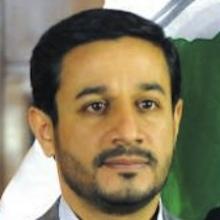
Spokesman
Chair of AAH’s political bloc, al-Sadiqun
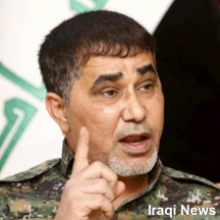
Commander and spokesman
Co-founder; former commander of Syrian branch
Founder and secretary-general
Leader
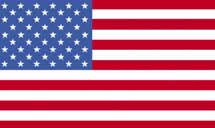
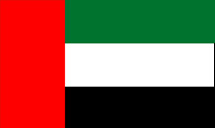
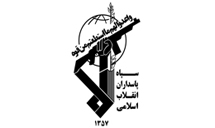
AAH enjoys the patronage of the Iranian state, which is dominated by the Islamic Revolutionary Guards Corps (IRGC).Babak Dehghanpisheh, “Special Report: The fighters of Iraq who answer to Iran,” Reuters, November 12, 2014, http://www.reuters.com/article/2014/11/12/us-mideast-crisis-militias-specialreport-idUSKCN0IW0ZA20141112. The IRGC’s elite Quds Force unit is the key exporter of Iranian-sponsored terrorism and guardian of the regime’s nuclear and ballistic missiles programs. AAH explicitly esteems the Iranian revolutionary regime and its theocratic figureheads.Liz Sly, “Iranian-backed militant group in Iraq is recasting itself as a political player,” Washington Post, February 18, 2013, http://www.washingtonpost.com/world/middle_east/iranian-backed-militant-group-in-iraq-is-recasting-itself-as-a-political-player/2013/02/18/b0154204-77bb-11e2-b102-948929030e64_story.html. Qasem Soleimani, the deceased leader of the IRGC’s Quds Force, was reportedly AAH’s “main patron.”Martin Chulov, “Controlled by Iran, the deadly militia recruiting Iraq’s men to die in Syria,” Guardian (London), March 12, 2014, http://www.theguardian.com/world/2014/mar/12/iraq-battle-dead-valley-peace-syria.

A strong proponent of Shiite dominance in Iraq, AAH is ideologically aligned with, and a “close all[y]” of, the main Shiite extremist group in Lebanon, Hezbollah. AAH has reportedly enjoyed a “close relationship” with the Lebanese militant group, and has sought to emulate Hezbollah’s modus operandi by establishing social services and religious schools throughout Iraq.Liz Sly, “Iranian-backed militant group in Iraq is recasting itself as a political player,” Washington Post, February 18, 2013, http://www.washingtonpost.com/world/middle_east/iranian-backed-militant-group-in-iraq-is-recasting-itself-as-a-political-player/2013/02/18/b0154204-77bb-11e2-b102-948929030e64_story.html.
In December 2017, AAH leader Qais al-Khazali visited Lebanon’s border with Israel on a trip organized by Hezbollah. He released a video clip in which he vowed that AAH would stand with Hezbollah and support the Palestinian cause.“Iraqi Militias Vow to ‘Defend Jerusalem’ After Trump Annoucement, Al Bawaba, December 9, 2017, https://www.albawaba.com/loop/iran-backed-iraqi-militia-leader-filmed-israeli-border-1058660; “Lebanese PM slams visit by Iran-backed Iraqi militia chief to Israeli border,” Times of Israel, December 9, 2017, https://www.timesofisrael.com/lebanese-pm-slams-iran-backed-iraqi-militia-visit-to-israel-border/.
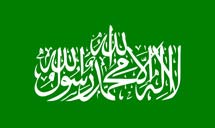
According to research analyst Sam Wyer at the Institute for the Study of War, AAH has ties to Palestinian group Hamas. In October 2011, AAH’s Beirut office representative Ammar al-Delphi reportedly met with Hamas official Ali Baraka during a seminar on Iraqi Resistance.Sam Wyer, “The Resurgence of Asa’ib Ahl al-Haq,” Middle East Security Report 7 (December 2012): 20, http://www.understandingwar.org/sites/default/files/ResurgenceofAAH.pdf.
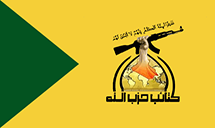
Formed a few months prior to the 2003 Iraq War, Kata’ib Hezbollah (KH) is an Iraqi paramilitary extremist organization. AAH and KH, along with the Badr Organization, comprise Iraq’s anti-ISIS popular mobilization forces (PMF).Phillip Smyth, “Iranian Proxies Step Up Their Role in Iraq,” Washington Institute for Near East Policy, June 13, 2014, http://www.washingtoninstitute.org/policy-analysis/view/iranian-proxies-step-up-their-role-in-iraq. In battles against ISIS, there is some degree of cooperation between the militias, though each militia leader ultimately retains his autonomy.Anne Barnard, “A Balancing Act as Iraq Claims Gains in Tikrit,” New York Times, March 12, 2015, http://www.nytimes.com/2015/03/13/world/middleeast/tikrit-isis-iraq.html. IRGC-Quds Force commander Qasem Soleimani reportedly coordinated military operations for all three militias before his death in January 2020.Babak Dehghanpisheh, “Special Report: The fighters of Iraq who answer to Iran,” Reuters, November 12, 2014, http://www.reuters.com/article/2014/11/12/us-mideast-crisis-militias-specialreport-idUSKCN0IW0ZA20141112; Simon Kerr, Chloe Cornish, and Andrew England, “Middle East braced for backlash after killing of Qassem Soleimani,” Financial Times, January 3, 2020, https://www.ft.com/content/52a2fce4-2e0f-11ea-a126-99756bd8f45e. AAH founder and leader Qais al-Khazali met with KH leaders Hashem Abu Alaa and Adnan al-Hamidawi in December 2011.Sam Wyer, “The Resurgence of Asa’ib Ahl al-Haq,” Middle East Security Report7 (December 2012): 13, http://www.understandingwar.org/sites/default/files/ResurgenceofAAH.pdf. The United States launched airstrikes against KH targets around Baghdad on March 12, 2020, in response to what it called the “threat posed by Iranian-backed Shia militia groups … who continue to attack bases hosting … coalition forces.”“Statement by the Department of Defense,” U.S. Department of Defense, March 12, 2020, https://www.defense.gov/Newsroom/Releases/Release/Article/2110827/statement-by-the-department-of-defense/.
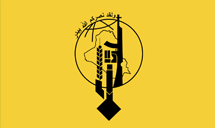
The Badr Organization, Kata’ib Hezbollah, and AAH are known as “Iran’s three big Iraqi militias.” While the direct ties between the Badr Organization and AAH are not clearly documented, it seems likely that there is some degree of cooperation given their shared loyalty to Iran’s IRGC-Quds Force commander Qasem Soleimani, who reportedly coordinated all three before his death in January 2020.Babak Dehghanpisheh, “Special Report: The fighters of Iraq who answer to Iran,” Reuters, November 12, 2014, http://www.reuters.com/article/2014/11/12/us-mideast-crisis-militias-specialreport-idUSKCN0IW0ZA20141112; Simon Kerr, Chloe Cornish, and Andrew England, “Middle East braced for backlash after killing of Qassem Soleimani,” Financial Times, January 3, 2020, https://www.ft.com/content/52a2fce4-2e0f-11ea-a126-99756bd8f45e.
AAH acts as an Iranian proxy, and as such has “displayed its commitment to figures of the ‘tradition of the Iranian Revolution,’ including Ruhollah Khomeini, Ali Khamenei, Kazim al-Haeri, and Mahmoud Hashemi Shahroudi.”Sam Wyer, “The Resurgence of Asa’ib Ahl al-Haq,” Middle East Security Report 7 (December 2012): 9, http://www.understandingwar.org/sites/default/files/ResurgenceofAAH.pdf.
AAH leader Qais al-Khazali has inspired thousands of Shiite Iraqis to volunteer in Syria in support of the Assad regime.Martin Chulov, “Controlled by Iran, the deadly militia recruiting Iraq’s men to die in Syria,” Guardian (London), March 12, 2014, http://www.theguardian.com/world/2014/mar/12/iraq-battle-dead-valley-peace-syria. AAH spokesman Ahmad Kanani asserts that the group’s militants “are not fighting alongside Syrian regime forces, but rather their mission is limited to the defense of holy places.”Hamza Mustafa, “Assad’s Unofficial Iraqis,” Asharq Al-Awsat (London), April 14, 2014, http://www.aawsat.net/2014/04/article55331166/assads-unofficial-iraqis. Some AAH militants have allegedly fought in the Abu al-Fadl al-Abbas Brigade, a pro-Assad militia composed of local and foreign Shiite fighters, including AAH, Lebanese Hezbollah, and Kata’ib Hezbollah.Will Fulton, Joseph Holliday, and Sam Wyer, “Iranian Strategy in Syria,” Institute for the Study of War, May 2013, http://www.understandingwar.org/sites/default/files/IranianStrategyinSyria-1MAY.pdf. According to a Guardian article from March 2014, AAH is increasingly “calling the shots” in both Iraq and Syria.Martin Chulov, “Controlled by Iran, the deadly militia recruiting Iraq’s men to die in Syria,” Guardian (London), March 12, 2014, http://www.theguardian.com/world/2014/mar/12/iraq-battle-dead-valley-peace-syria.
The three main Shiite militias in Iraq—AAH, the Badr Organization, and Kata’ib Hezbollah—were reportedly overseen by Iran’s military envoy to Iraq, the IRGC-Quds Force’s Qasem Soleimani.Babak Dehghanpisheh, “Special Report: The fighters of Iraq who answer to Iran,” Reuters, November 12, 2014, http://www.reuters.com/article/2014/11/12/us-mideast-crisis-militias-specialreport-idUSKCN0IW0ZA20141112. Soleimani died in a January 2, 2020, U.S. airstrike in Iraq.Simon Kerr, Chloe Cornish, and Andrew England, “Middle East braced for backlash after killing of Qassem Soleimani,” Financial Times, January 3, 2020, https://www.ft.com/content/52a2fce4-2e0f-11ea-a126-99756bd8f45e. According to Iraqi officials, Soleimani knew the heads of each militia personally.Babak Dehghanpisheh, “Special Report: The fighters of Iraq who answer to Iran,” Reuters, November 12, 2014, http://www.reuters.com/article/2014/11/12/us-mideast-crisis-militias-specialreport-idUSKCN0IW0ZA20141112. Soleimani was allegedly AAH’s “main patron”. The group reportedly exhibits Soleimani’s methods of influence, “a mix of strategic diplomacy, aggressive military operations and intimidation.”Martin Chulov, “Controlled by Iran, the deadly militia recruiting Iraq’s men to die in Syria,” Guardian (London), March 12, 2014, http://www.theguardian.com/world/2014/mar/12/iraq-battle-dead-valley-peace-syria.
Extremists: Their Words. Their Actions.
Fact:
On May 8, 2019, Taliban insurgents detonated an explosive-laden vehicle and then broke into American NGO Counterpart International’s offices in Kabul. At least seven people were killed and 24 were injured.
Get the latest news on extremism and counter-extremism delivered to your inbox.